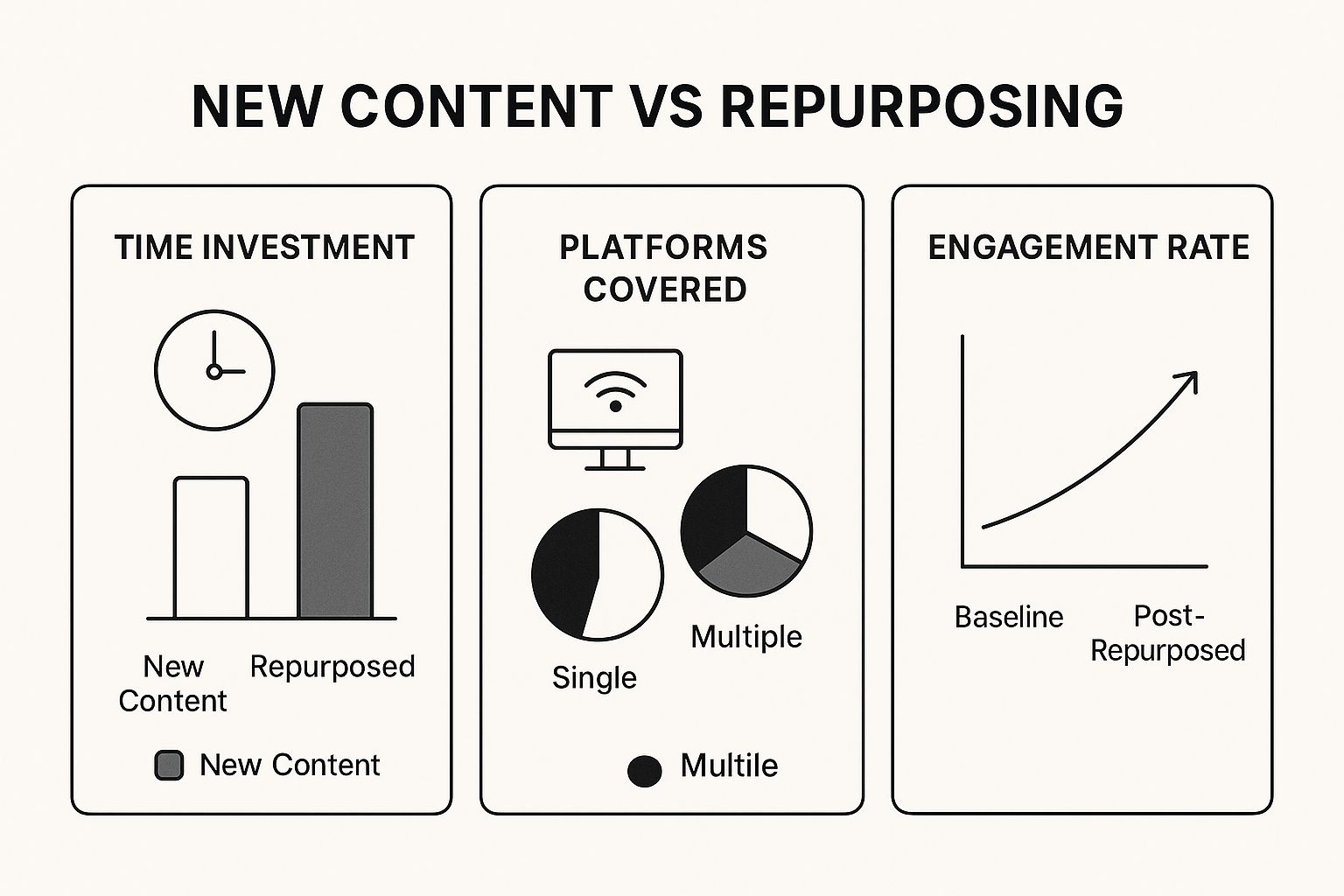Repurposing Content for Social Media: Boost Your Strategy

Why Smart Marketers Swear by Content Repurposing

Creating fresh social media content day in and day out can feel like a constant uphill battle. But here’s a little secret: successful marketers rarely start from a blank page. They’re pros at content repurposing for social media, morphing existing work into engaging new formats. This isn’t about being lazy; it's about working smarter. Think of a chef using quality ingredients to whip up a whole menu of delicious dishes.
One of the biggest perks? It saves a ton of time. Instead of constantly starting from scratch, repurposing lets you squeeze every drop of value from what you’ve already created. Imagine turning a webinar recording into quick video snippets for Instagram and TikTok, pulling key takeaways into a Pinterest infographic, or designing insightful quotes into eye-catching Twitter posts. You free up time and keep your brand visible across different platforms. For some proven strategies, check out this article on content repurposing strategies to boost ROI.
Repurposing also lets you connect with different learning styles and platform preferences. Some people love video, others prefer text, and some are all about the visuals. By offering your content in a variety of formats, you expand your reach and engage a much broader audience. Plus, repurposing isn't just about finding new followers; it’s about reinforcing your message with your current ones. Seeing your key themes pop up in fresh ways helps solidify your brand messaging and builds stronger connections. For more on maximizing your content investment, dive into these content repurposing strategies.
Content Repurposing: By the Numbers
This strategy has become so vital that a whopping 94% of marketers are now repurposing their content across different channels. This not only speeds up content creation but also taps into the massive reach of social media—a global audience of 5.24 billion users! Tailoring your content to each platform—think blog posts transformed into infographics or long videos into short tutorials—boosts engagement and visibility. For more on maximizing your reach, see this article on content repurposing in 2025.
To help illustrate the impact of repurposing across various platforms, take a look at the table below:
Content Repurposing Impact Across Different Channels Comparison of engagement rates and reach potential when repurposing content across major social media platforms
| Platform | Best Repurposed Format | Average Engagement Increase | Optimal Posting Frequency |
|---|---|---|---|
| Carousels, Short-Form Videos | Can vary, but often 10-20% higher than single image posts | 1-2 times per day | |
| Threads, Quote Graphics | Can see increases of 5-15% with engaging visuals | 3-5 times per day | |
| Longer Videos, Blog Post Excerpts | Engagement boost can range from 5-10% with targeted sharing | 1-2 times per day | |
| Articles, Short Videos, Text Posts with Images | Engagement lift can be significant, 10-20% or more, with professional content | 2-3 times per week | |
| Infographics, How-To Guides | 15-25% improvement possible with visually appealing content | 5-10 times per day | |
| TikTok | Short, engaging videos, often repurposed from other platforms | Highly variable, but potential for viral reach | 1-3 times per day |
As you can see, tailoring your content to each platform's strengths can significantly impact engagement. Choosing the right format and posting frequency is key to maximizing your reach and making the most of your repurposed content. This shift isn't just a fleeting trend; it's a core change in how successful marketers create content.
Finding Hidden Gold in Your Content Library
Let's face it, you're likely sitting on a treasure trove of content just waiting to be repurposed. Savvy marketers who truly get repurposing treat their existing content differently. They don't see finalized blog posts or videos, but rather raw, adaptable material ready for a new life on social media. I've seen this strategy transform marketing efforts time and again.
So, where do you begin? A well-structured content audit is key. Instead of just listing out every piece of content you have, categorize it. Think about evergreen content – those pieces that stay relevant no matter what’s trending. For example, that helpful guide on crafting compelling email subject lines will always be valuable, while a post about a specific algorithm update might quickly become outdated.

This screenshot from Buffer highlights different content repurposing methods, demonstrating how adaptable content can be. Turning blog posts into infographics or pulling key quotes from webinars are great examples of giving existing content new life.
Look at your top-performing content too. High engagement on a blog post or video is a good sign that it resonated with your audience. This is a strong indicator of repurposing potential. From personal experience, transforming high-performing content into visually-driven carousels using a tool like Lumeo can significantly boost engagement, particularly on platforms like LinkedIn and Instagram.
Creating a Content Hierarchy
After categorizing your content, create a hierarchy. This prioritizes your repurposing efforts. At the top are your pillar pieces—that comprehensive, evergreen content forming the foundation of your content strategy. Supporting pieces that explore specific aspects of your pillar content fall underneath. This prevents wasted time on low-impact content.
For example, a pillar piece could be a detailed guide to social media marketing. Supporting content might include blog posts focusing on individual platforms, video tutorials demonstrating specific tactics, or infographics summarizing key data points. This structured approach helps you repurpose strategically, ensuring your message stays consistent and effective. This organized system also makes content discovery much easier, preventing your hard work from getting lost in the digital abyss.
By implementing these frameworks and creating a clear system, you can truly unlock the potential within your content library. Shifting from constant content creation to strategic repurposing can drastically improve your efficiency and reach.
Platform-Native Repurposing That Actually Works
Repurposing content for social media is great for saving time, but there's a catch: just copying and pasting the same piece across all platforms won't get you very far. Every platform has its own unique culture, audience, and best practices. What flies on LinkedIn might totally flop on TikTok, and the other way around. Think of it like your wardrobe – you wouldn’t wear a business suit to the beach or a swimsuit to a board meeting!

The infographic above highlights some compelling data. Look at how much time repurposing saves compared to creating fresh content for every platform. Plus, repurposing often gets better engagement! This makes a strong case for making it a core part of your social media strategy.
Adapting Your Content for Each Platform
So, how do you make your content feel at home on each platform? It's all about adaptation. Let's say you have a blog post you want to share. On LinkedIn, you could turn it into a carousel using Lumeo, pulling out key takeaways and pairing them with professional-looking visuals and insightful commentary. This approach really resonates with LinkedIn’s business-minded audience.
But that same blog post would look different on Instagram. Think a series of Stories with quick tips, polls, and questions to get your audience involved. Shorter, snappier, and more visual – perfect for Instagram's fast-paced, image-driven environment.
Beyond Simple Reformatting
And how about TikTok? Here, your blog post could transform into a short, eye-catching video. Maybe you demonstrate a key concept or highlight a surprising statistic, all set to a trending sound. This plays to TikTok's love of entertainment and short-form video. On Twitter, that blog post could become a thought-provoking thread, sparking discussion and encouraging interaction.
The point is, repurposing isn’t just about changing the format – it's about understanding each platform's unique personality. On LinkedIn, keep it professional and insightful. Instagram? More casual and visually driven. TikTok thrives on creativity and humor. Twitter? Concise, engaging commentary is key.
Maximizing Engagement on Every Platform
From my experience, even small tweaks in your language and visuals can dramatically impact how your audience perceives your brand. By adapting not only the format but also the tone and style of your content, you make it feel natural and engaging on each platform.
To really nail this, think about using social media content creation tools. They can streamline the repurposing process and help you optimize your content for each platform's specific needs. By respecting each platform’s individual character, you go beyond simply recycling content to true strategic repurposing. It's the difference between a generic echo and a targeted message that genuinely resonates with your audience, building stronger connections and generating significantly better engagement across all your social channels.
To help you visualize this, here's a handy guide:
Platform-Specific Content Adaptation Guide Detailed breakdown of how to adapt different content types for optimal performance on each major social media platform
| Original Format | TikTok | YouTube | |||
|---|---|---|---|---|---|
| Blog Post | Series of Stories with quick tips, polls, and engaging questions | Carousel highlighting key takeaways with strong visuals and professional commentary | Short, engaging video demonstrating a key concept or statistic set to trending music | Thought-provoking thread sparking discussion | In-depth video discussion expanding on blog post concepts |
| Webinar | Short, engaging clips promoting key takeaways and driving traffic to the full recording | Carousel summarizing key insights and promoting the full recording with a professional call to action | Short, attention-grabbing teasers with engaging visuals and trending audio | Thread highlighting key takeaways and promoting registration/recording | Upload the full webinar recording with optimized title and description |
| Infographic | Break down the infographic into individual slides for a carousel, highlighting key data points | Share the full infographic with a professional summary and insightful commentary | Create a short, animated video summarizing the key data points with engaging visuals and music | Share key statistics from the infographic with concise commentary and a link to the full version | Create a video explaining the data and insights presented in the infographic |
This table gives you a quick reference for how to tailor different content formats to each platform. Remember, the key is to consider what kind of content thrives on each platform and adapt your message accordingly!
Tools and Systems That Actually Save Time
Repurposing content for social media doesn't have to feel like a second job. The trick is finding the right systems and tools to make the process smooth and efficient. Let's ditch the fluff and get down to the practical stuff. We'll explore everything from simple organizational tips to AI-powered platforms, highlighting what’s genuinely worth your time (and money).
Organization Is Your Secret Weapon
Before you jump into any fancy software, remember the basics: good organization. A well-structured content library is crucial. Think of it as your personal content supermarket – you can quickly grab what you need (a blog post snippet, a killer quote, a striking image) when you know exactly where everything is.
I personally use a simple spreadsheet, but project management tools like Trello or Asana work wonders too. Categorize your content by topic, format, and where it might fit best on social media. For example, tag a blog post about email marketing with "email," "blog post," "LinkedIn," and "Instagram." This makes it a breeze to find later when you’re planning social media content.
Leveraging AI for Efficiency
Now, let’s talk about AI. Platforms like Lumeo can be absolute game-changers for social media repurposing. They can take a blog post and transform it into a visually appealing carousel in minutes, saving you hours of design work.

This Lumeo screenshot shows just how intuitive the interface is. It's super easy to customize the look and feel of your carousels, making sure they're perfectly on-brand. And trust me, that visual polish is essential for grabbing attention on platforms like LinkedIn and Instagram.
Automation for the Win
Automation is another secret weapon in the repurposing arsenal. Tools like Buffer and Hootsuite let you schedule your repurposed content across multiple platforms in advance. This frees up your time to focus on strategy and engaging with your audience, rather than manually posting every single update. For powerful platform-native repurposing, check out some of the great social media content creation tools available.
Finding the Right Balance
While tools are incredibly helpful, they’re just that—tools. Your strategy is what really brings everything together. Choose tools that fit into your workflow, not the other way around. Don't get caught up in trying every shiny new app. Instead, focus on what actually addresses your needs and helps you achieve your repurposing goals. You might also find this helpful: social media content creation. By combining smart organization with the right tools and a bit of automation, you can transform your repurposing workflow from a time-consuming chore into a streamlined process that saves you time and amplifies your message.
Amplifying Your Message Through Strategic Timing
Repurposing content for social media isn't just about changing the format. It's about strategically amplifying your message. Think of it like an orchestra – each instrument (content piece) plays its part at the right time for maximum impact. You want a symphony, not a cacophony of random notes. This means thinking bigger than individual posts and building a content ecosystem where each piece supports the others.
Creating a Content Calendar for Repurposed Content
One of the biggest mistakes I see is repurposing content without a roadmap. It’s like throwing darts blindfolded. Instead, create a dedicated content calendar for your repurposed material. This helps you see the bigger picture and keeps your messages from clashing.
For example, let’s say you write a fantastic blog post about social media trends. You can break that post into smaller pieces for different platforms. A quick tip for LinkedIn, a visually-driven carousel on Instagram (Lumeo makes this super easy!), a short video for TikTok – all timed strategically to build momentum.
Building Anticipation Through Content Series
Content series are a great way to build anticipation and keep your audience hooked. Think of short videos teasing a bigger announcement, a multi-part carousel on LinkedIn, or a week-long Instagram Story campaign. These tactics build excitement and encourage engagement. They also let you guide your audience through your entire content ecosystem, from a quick Tweet to a detailed blog post.
Speaking of long-term impact, repurposing has a real effect on traffic and engagement. It lets you grow your online presence without constantly starting from scratch. This is especially useful for SEO, where repurposed content can be optimized for different keywords. Turning a blog post into a podcast or video, for instance, caters to different learning styles. Plus, with social media ad spend projected to rise 9.37% annually between 2025 and 2030, using repurposed content in ad campaigns can really boost ROI. For more on this, check out these social media statistics.
Measuring What Matters
Finally, pay attention to the right metrics. When you're playing the long game, vanity metrics like likes and shares only tell part of the story. Focus on website traffic, lead generation, and brand mentions. These show whether your efforts are actually making a difference. To save some time, consider using some of these affordable tools to automate your social media. By focusing on strategic timing, building a strong content ecosystem, and tracking the right metrics, you can transform repurposed content from random recycling into a powerful growth engine.
Avoiding the Pitfalls That Kill Engagement
Repurposing content for social media is a smart move, but it's surprisingly easy to mess it up. I've seen it happen even to experienced marketers, so let's break down how to avoid the common traps.
The Copy-Paste Trap
The biggest offender? Mindlessly copying and pasting. Taking a blog post and dumping it onto Instagram without a second thought is a recipe for disaster. Your audience can smell recycled content a mile away, and it erodes trust. Every platform has its own personality. What flies on LinkedIn might flop on TikTok. Adjust your message, tone, and visuals to fit each space.
The Over-Repurposing Problem
Another frequent mistake is flogging a dead horse. Just because a piece of content performed well once doesn't mean it's timeless. Over-repurposing old content makes your brand feel stale. Regularly review your content library. If something isn't relevant anymore, let it go.
The Authenticity Drain
Repurposing efficiently is fantastic, but don't let it stifle your creativity. Becoming too dependent on repurposing can lead to a content drought. Your audience craves fresh insights and original ideas. Think of repurposing as a boost, not the main course. Find a healthy balance between efficiency and creating something new. You might find this helpful: how to get more engagement on LinkedIn.
Losing Sight of Your Audience
It's easy to get caught up in the how of repurposing and forget the who. Always keep your audience front and center. What are their interests, needs, and preferred content formats? Tailor your repurposed content to resonate with them specifically on each platform.
Ignoring Platform Nuances
Every platform has its own quirks. Ignoring them makes your repurposed content feel awkward and forced. For example, LinkedIn loves professional insights and carousels made with tools like Lumeo, while Instagram thrives on visuals, stories, and short videos. Understand these differences and adapt your content accordingly.
By dodging these common mistakes and sticking to a smart strategy, you can use repurposing to amplify your message and connect with your audience on a deeper level, without losing that all-important authenticity.
Your Repurposing Action Plan
Let's get real about repurposing content for social media. Forget feeling overwhelmed and complicated workflows. We're building a simple, effective roadmap that actually gets results.
Auditing Your Content Goldmine
Think of a content audit as spring cleaning for your content. It's not about creating a massive, daunting project. Just start simple. A spreadsheet or a tool like Trello or Asana works perfectly. Categorize your existing content by topic, format, and where you might share it on social media. For example, if you have a blog post on productivity, tag it with "productivity," "blog post," "LinkedIn," and "Instagram." This makes it easy to find later.
Now, identify your evergreen content. This is the stuff that stays relevant no matter what trends are happening. A guide on writing effective email subject lines? Evergreen. A post about a specific algorithm update? Probably not. Prioritize that evergreen content for repurposing.
Finally, pinpoint your high-impact content. Check your past engagement. What really resonated with your audience? Was it a blog post with a ton of shares or a video with high watch time? These are your golden tickets for repurposing. Personally, I've seen amazing results by turning these high-performers into visually appealing carousels, especially when using a tool like Lumeo. It can really boost engagement, particularly on platforms like LinkedIn.
Streamlining Your Workflow
Now you know what to repurpose. Let's talk about how. The key is finding a system that works for you. Don’t overcomplicate it. Start small and adjust as you go.
Batching is a great way to do this. Set aside dedicated time for repurposing. Maybe it's Friday afternoons or one morning a week. During this time, focus only on transforming your chosen content into social-media-ready formats. This helps you maintain focus and avoid constantly switching tasks.
Tracking is crucial too. How do you know if your efforts are actually working? Don't just look at vanity metrics like likes and shares. Track website traffic, lead generation, and brand mentions. These give you a much better understanding of your true impact.
Starting Small, Scaling Up
Start with a few high-potential pieces and experiment with different formats on different platforms. Don’t try to repurpose your entire content library at once. As you get more comfortable and refine your process, gradually ramp up your efforts.
Remember, repurposing is about working smarter, not harder. It’s about making the most of what you already have and reaching a wider audience without constantly reinventing the wheel. By focusing on these practical steps, you can create a sustainable repurposing strategy that delivers real, tangible results.
Ready to turn your content into engaging social media carousels? Start creating with Lumeo today!